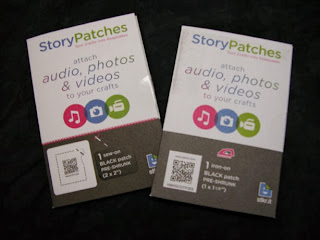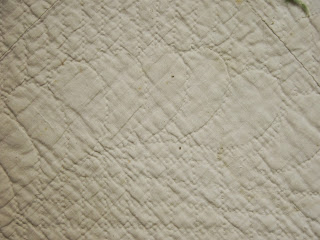Every time I finish a quilt, I make a big ceremony of creating a label for the back. It's true I didn't make this Red and Green Tulip, but I have put in considerable effort into restoring it. What should I include on this label?
It would be nice to have a little story about the quilt, where it came from and who fixed it etc. But that would make a pretty big label! Usually, I iron a piece of treated fabric onto freezer paper and send it through my printer. After pressing it, I sew on a border, sometimes add some embroidery, and sew it on the quilt back.
Something came across my desk in October that has presented another idea for the label. It includes a QR code, which connects a person to a website that includes all the information. I haven't played with this yet, but it is a great idea for quilts given as gifts. What is it?
Ask your quilt shop to carry them. Let me know how you like them. I do have some questions about the lifetime of the product. They suggest hand washing or machine washing inside out. You may sew on the outside edge of the label, but no through the code itself. But how long will your message be stored online? Will it be there when your great grandchildren read the code? Or will they even know what it is?
I'd like feedback from those of you that have used them. They seem like a wonderful idea for making a more personal label.
Still sewing red and green tulips.
Ann Fahl
It would be nice to have a little story about the quilt, where it came from and who fixed it etc. But that would make a pretty big label! Usually, I iron a piece of treated fabric onto freezer paper and send it through my printer. After pressing it, I sew on a border, sometimes add some embroidery, and sew it on the quilt back.
 |
| Here are the stkr.it packages |
Something came across my desk in October that has presented another idea for the label. It includes a QR code, which connects a person to a website that includes all the information. I haven't played with this yet, but it is a great idea for quilts given as gifts. What is it?
They are called Story Patches. More information can be found here. I now have a smart phone with a qr code reader so I'll play with it a little bit and report back to you. Each label is:
- Modestly priced
- Either a sew-on or an iron-on patch
- Incorporate the patch on a quilt label on the back or in your patchwork on the front!
- Available in black, blue, green, pink and red
- Attach audio, photos, messages and videos about the quilt
- Use your imagination there are many possibilities for their use
- www.stkrit.com
- contact@stkr.it
 |
| On the left you can see the sew-in label. |
Ask your quilt shop to carry them. Let me know how you like them. I do have some questions about the lifetime of the product. They suggest hand washing or machine washing inside out. You may sew on the outside edge of the label, but no through the code itself. But how long will your message be stored online? Will it be there when your great grandchildren read the code? Or will they even know what it is?
I'd like feedback from those of you that have used them. They seem like a wonderful idea for making a more personal label.
Still sewing red and green tulips.
Ann Fahl







